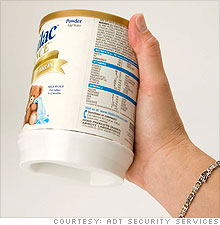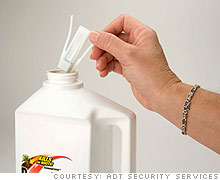Stores' holiday-time hazard: Shoplifters
As sellers work with smaller staffs during a very busy sales period, it puts them at a greater risk of losing merchandise to thieves.
 |
| Baby food is routinely one of the most shoplifted items, experts say. |
 |
| Expensive bottles of weedkiller are prime targets for thieves trolling Home Depot stores. |
NEW YORK (CNNMoney.com) -- Even with stores desperate to make every sale they can this holiday season, there's one type of customer that merchants don't want at all: Shoplifters.
The bad news this year is that most stores are at a greater risk of losing their merchandise to thieves.
Experts say it's an unfortunate side effect of the recession.
"Retailers hired fewer seasonal holiday workers this year, so the opportunity to steal goes up," said Lee Pernice, a retail security expert with ADT Security Services, which has more than 80 global retail clients.
The November-December period typically is the most robust and critical sales period of the year for merchants because it can account for as much as 50%, or more, of their sales and profits for the entire year.
Most big sellers usually hire more workers to better manage the crowds of gift shoppers during the weeks leading up to Christmas.
But last year, retailers cut their holiday hiring by 62% from the previous year, according to industry estimates.
As a result, store theft increased for the first time in six years, to a rate of 1.5% of total retail sales, or $36.3 billion lost. The rate was up from 1.4% in 2007, according to the University of Florida's National Retail Security Survey (NRSS) of 103 leading U.S. store chains.
"It's not going to be any better this year," predicted Pernice.
For example, she said that, in the past 12 months, there has been an increase in reports of "pushouts," people loading up shopping carts with groceries and then running out the door.
And because most sellers have a "non-pursuit" policy in place, meaning that employees cannot chase after a thief for safety reasons, stores end up having to absorb the cost of a pushout.
In department stores, the most vulnerable products are "branded" clothing, such as Ralph Lauren.
Branded merchandise is highly desired by both shoplifters who steal for themselves and organized groups or gangs that make a living by going store-to-store and stealing, usually in large quantities for resale.
"Branded clothing can bring in 60 cents on the dollar versus 30 cents on the dollar for a non-branded item," said Pernice.
Industry watchers say much of the merchandise that's targeted by gangs ends up being sold online, in flea markets or in unauthorized temporary markets.
"A lot of [the money] funds criminal activity. So there's a societal cost on top of an economic cost of these trends," Joshua Bamfield, an expert on retail crime with U.K.-based Center for Retail Research, told CNNMoney.com last month.
In supermarkets and drugstores, meat, baby formula and over-the-counter medicine are routinely among the most-filched products. "Supermarkets survive on very thin [profit] margins," said Pernice. "Every time a product is stolen, it hurts these stores a little bit more."
Power tools, and surprisingly, weedkiller, are very popular with thieves at Home Depot (HD, Fortune 500), which is a client of ADT.
"Power tools are very easy to resell," said Pernice. "You can pawn them online or sell them to workers on a construction site."
Some bottles of weedkiller are expensive, as much as $100 or more per bottle. "I never thought weedkiller needed protection," said Pernice
Games, gaming software and consoles such as the Wii are regularly targeted at electronics stores. So are 42-inch TVs.
Just how do you steal a 42-inch TV? "It's either employee theft where it's done on the inside, or sometimes people create a diversionary tactic," Pernice said. "You set off the alarm in the front of the store and someone leaves with the product from the back."
Pernice said stores are using technology to fight the problem. Their focus is not only aimed at deterring criminals but at preventing offenders from coming back to the store again, which is the bigger problem for retailers.
"It's amazing how far people will go to defeat anti-theft technology," she said. "There was one person who was caught at a New York City department store who had lined their underwear with foil and hid products in the underwear." .
Among the newest anti-theft technology are "smarter" cameras. "These cameras know if within so many seconds, one or two boxes of a product were removed from a shelf or if the entire shelf was cleared," said Pernice.
If the shelf goes from full to empty in 10 seconds, an alert is sent, she said. "The camera gives you a picture of who did it."
And because all the smart cameras in a store are able to talk to each other, the the cameras follow the "offender" throughout the store, making it harder for the person to get away with the merchandise.
According to ADT, retailers can share the footage with the law enforcement, including the Federal Bureau of Investigation (FBI), to crack down on organized gangs of shoplifters.
ADT has also developed a security tag that can go inside bottles of caustic liquids, such as weedkillers. "We also have an FDA approved [security] label that can be put inside a bottle of vitamins or dry goods," she said.
The idea is to hide the anti-theft device so shoplifters aren't aware that the product will sound an alarm if an attempt is made to steal it, and to deter the offender from attempting to steal products from the store again.
Its newly developed "people-counting" device tells stores how many people came in during a specific time period versus sales during that time.
The device can alert a retailer when there's a big discrepancy in the purchase rates between two stores that have the same level of customer traffic -- an indication that something might be amiss, said Pernice.
One activity that merchants are trying to curb is called "sweethearting," said Pernice, in which an employee will pass along merchandise to a customer without charging them for it.
"In today's environment where there are less employees in stores, technology has to play a bigger role in providing protection," she said.
"Retail crime is not a victimless crime," Pernice said. "We all get hurt because there's less merchandise on shelves and retailers push up their prices." ![]()

